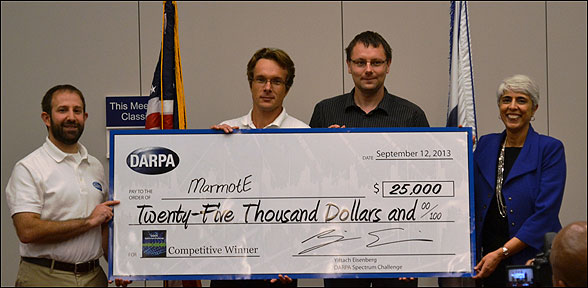
After two days of live competition, a team of engineers from Vanderbilt’s Institute for Software Integrated Systems emerged as a top winner for their prototype software-defined radio that can communicate in adverse spectrum environments, and earned a $25,000 prize.
The preliminary matches, held in mid-September in Arlington, Va., included 15 teams selected to enter the competition after completing a qualifying phase this spring with 90 teams from across the country that initially registered for the Defense Advanced Research Projects Agency (DARPA) Spectrum Challenge. The preliminary tournament also included three ‘wildcard’ teams. The Spectrum Challenge final event is in March 2014.
Vanderbilt’s team, MarmotE, claimed first place in the Competitive Tournament. This event tested conditions directly applicable to military communications, where radios must deliver high-priority data in congested and often contested electromagnetic environments. Tennessee Tech Telecom, a team from Tennessee Tech University, was the runner-up.
In competitive matches, two teams battled to dominate the spectrum. Teams had to evade, jam and/or operate in the presence of competitors’ signals within a defined 5 MHz UHF band. The winner was the first to transmit files or the greatest portion of files from a source radio to a destination radio.
Northeastern University’s team, WSL-NEU, won the Cooperative Tournament and $25,000. This event tested conditions that might be encountered during coalition operations, and also has possible future commercial applications. Wasabi, an independent team, came in a close second.
In cooperative matches, three teams worked together to share the spectrum and transmit their random data files in the shortest time. Teams could not coordinate in advance on how to share the spectrum, so they had to develop and implement algorithms that enabled their software-defined radios to communicate at a high rate while leaving spectrum for the other two teams to do the same.
Final Challenge in March
The Final Challenge competition in March will follow the same structure as the preliminaries but award twice the prize money—$50,000 per winning team. The competitive and cooperative events will be multiple-elimination and each team will play at least three matches. All 18 teams are scheduled to play both events. In all, the DARPA Spectrum Challenge plans to award $150,000 in prizes.
“The preliminary tournament dramatically changed our thinking about the Cooperative Challenge. Our team will focus on developing a truly adaptive strategy for the next event. This involves a completely new radio design and a drastic departure from the Competitive radio architecture,” said Peter Volgyesi, research scientist at ISIS and leader of Vanderbilt’s MarmotE team.
Other team members are Peter Horvath, a postdoctoral scholar; Sandor Szilvasi and Benjamin Babjak, electrical engineering graduates students and research associates at ISIS; and Miklos Maroti, visiting professor at ISIS from the University of Szeged, Hungary.
“The winning strategy was developed by Miklos Maroti, while Peter Horvath provided us with invaluable insights in wireless communication,” Volgyesi said. “Most of our software-defined radio expertise was developed during the past few years in projects sponsored by the Networking Technology and Systems (NeTS) Program and Cyber-Physical Systems (CPS) Program of the National Science Foundation.”
These projects funded the doctoral research of team members Szilvasi and Babjak, which resulted in a new low-power software-defined radio platform named MarmotE.
Volgyesi said the DARPA Spectrum Challenge is very well aligned with the research directions and the timing of these projects. “Our participation is a good example of how ISIS fosters multidisciplinary research and is always open to new directions.”
Increase in innovation
DARPA provided all teams with the same hardware and data to ensure that each team would win or lose based on their software algorithms alone. All matches occurred on the ORBIT testbed at Rutgers University’s WINLAB, which streamed the proceedings live to DARPA where contestants and government personnel watched the event unfold.
To help competitors see how their software compared with other teams’ designs, WINLAB developed data visualization technology for DARPA that showed the specific radio frequencies each team used and their progress in transmitting the test file. Based on color-coded spectrum occupancy patterns projected on large screens in the event hall, watchers could see how the radios interacted and infer each team’s likely strategies in real time.
“The insights the teams gained today should give them their ‘big idea’ for the finals,” said Yiftach Eisenberg, DARPA program manager heading the Spectrum Challenge. “I expect we’ll see a massive increase in innovation when many teams come back six months from now with completely new designs. Those designs hopefully will build off the baseline algorithms and techniques we saw, and show us for the first time the reasoning and adaptive capabilities DARPA seeks to deliver.”
“I’m impressed with the creativity, enthusiasm, and performance of the teams that we’ve seen here today,” said DARPA Director Arati Prabhakar, who attended the final matches of both tournaments. “Their original contributions hold great promise in this fast-moving field.”
More information about the Spectrum Challenge is available at http://go.usa.gov/bqQW.
MORE: ISIS’ MarmotE team qualifies for DARPA Spectrum Challenge April 16, 2013